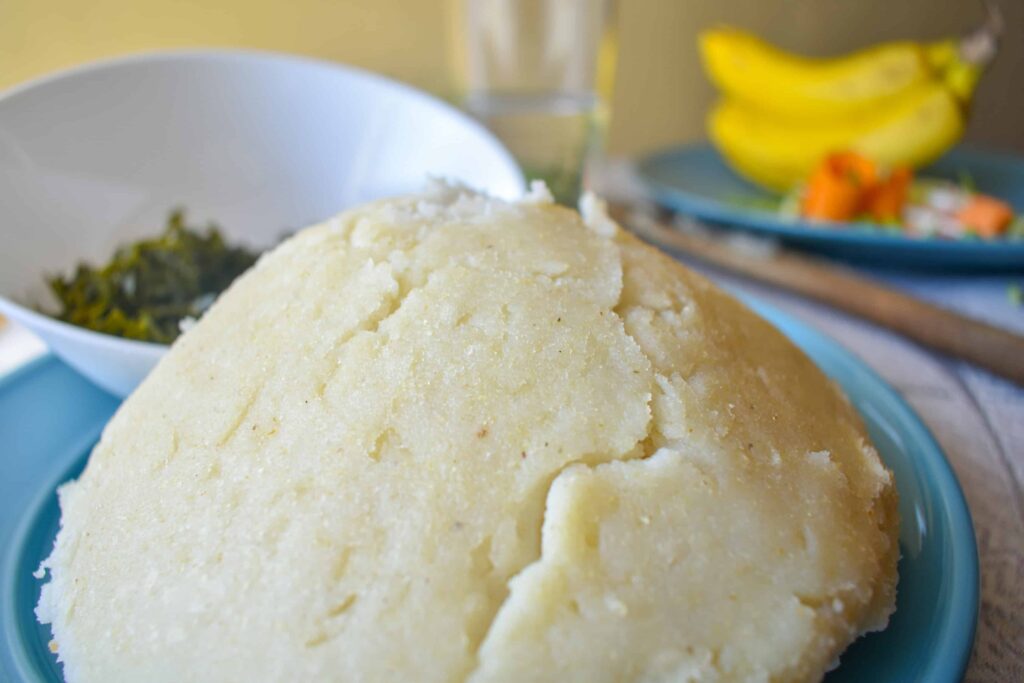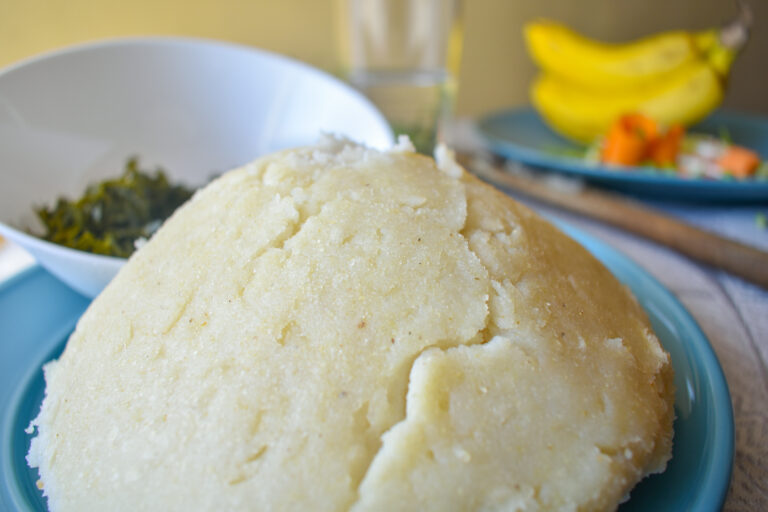
Ugali, a staple food in Kenya, is a simple dish that holds a special place in the hearts of its people. This humble meal, made from cornmeal and water, has been nourishing Kenyans for generations.
Our team at Remitly created this guide as part of our series that celebrates the culinary cuisine of our customers around the world.
The History of Ugali in Kenya
The history of Ugali in Kenya dates back to pre-colonial times. It was then that maize was introduced to Africa from the Americas. Over time, this grain became an integral part of Kenyan agriculture and diet.
Ugali’s popularity grew due to its simplicity and affordability. It required few ingredients and could be easily prepared even under challenging conditions. This made it a favored choice among many Kenyan households.
Ingredients and Preparation of Ugali
Preparing Ugali is straightforward. The primary ingredients are maize flour and water. These are cooked together until they form a thick, dough-like consistency.
The process begins by boiling water in a pot. Once the water reaches boiling point, maize flour is gradually added while stirring continuously to prevent lumps from forming. The mixture is then cooked until it pulls away from the sides of the pot.
Recipe: How to Make Ugali
Ugali is a simple dish that requires minimal ingredients and preparation. Here’s a basic recipe you can follow.
Ingredients
- 2 cups of maize flour (cornmeal)
- 4 cups of water
- A pinch of salt (optional)
Instructions
- Bring the water to a boil in a heavy-bottomed pot.
- Once boiling, reduce the heat to low and slowly add the maize flour while stirring continuously.
- Continue stirring until the mixture thickens and starts pulling away from the sides of the pot.
- If desired, add a pinch of salt for flavor.
- Cook for about 10 more minutes, stirring frequently to prevent lumps from forming.
- Once cooked, turn out onto a plate and shape into a round mound using a wet spoon or spatula.
- Serve hot with your choice of accompaniment—vegetables, meat stew, or fermented milk.
Remember, practice makes perfect when it comes to making Ugali—the consistency can be tricky at first but gets easier with time.
Variations of Ugali Across Kenya
While the basic recipe for Ugali remains consistent across Kenya, there are regional variations that reflect local tastes and resources. In some areas, millet or sorghum flour may be used instead of maize flour.
In coastal regions where cassava is abundant, it’s often incorporated into the dish. Some communities also add butter or oil for extra flavor or richness—though this isn’t common practice everywhere.
Serving and Eating Etiquette for Ugali
Ugali is typically served hot alongside various accompaniments such as vegetables, meat stews or fermented milk known as Mursik. It’s traditionally eaten with hands—pinched off piece by piece using one’s right hand before being dipped into the accompanying dish.
It’s important to note that Ugali is more than just a meal—it’s a communal experience. Sharing Ugali is seen as an act of unity and friendship, reinforcing social bonds within the community.
Common Pairings with Ugali
Ugali pairs well with a variety of dishes. Sukuma wiki—a type of collard greens sautéed with onions and tomatoes—is a popular choice. Meat stews, fish, and beans are also often served alongside Ugali.
In western Kenya, it’s common to pair Ugali with chicken stew or Tilapia from Lake Victoria. In the coastal regions, coconut-based curries are favored accompaniments.
Influence of Ugali on Kenyan Cuisine
Ugali has significantly influenced Kenyan cuisine. Its versatility allows it to be paired with almost any dish—making it a constant presence at Kenyan meals.
Moreover, its simplicity has shaped the way Kenyans approach food—valuing nourishment and sustenance over complexity or extravagance. This ethos is reflected in many other aspects of Kenyan cuisine as well.
Personal Stories: Kenyans and their Love for Ugali
For many Kenyans, Ugali evokes memories of home and family. It’s often one of the first dishes children learn to cook—and one they continue to prepare throughout their lives.
There are countless stories about people’s love for this dish—from those who grew up eating it every day to those who discovered it later in life but quickly developed an appreciation for its comforting qualities.
The Global Reach of Ugali
While deeply rooted in Kenya, Ugali has found its way into kitchens around the world—thanks largely to the global diaspora. From London to Los Angeles, you’ll find restaurants serving this beloved dish—often introducing it to new audiences along the way.
Despite its humble origins, there’s no denying that Ugali has made a significant impact—not just on Kenya’s culinary landscape, but on the global stage as well. It’s a testament to the power of simple, nourishing food and its ability to bring people together—no matter where they are in the world.
Kenyan Cuisine: A Rich Tapestry of Flavors
Kenyan cuisine is as diverse as its people—reflecting various cultural influences over centuries.
Staple Foods in Kenya
Apart from Ugali, other staple foods include rice, potatoes, and chapati—a type of flatbread introduced by Indian immigrants. These are often served alongside vegetables or protein sources like beans, lentils, fish or meat.
Popular Kenyan Dishes
Githeri—a hearty stew made from corn and beans—is another popular dish enjoyed across Kenya. Nyama choma (grilled meat), usually goat or beef served with kachumbari (a fresh tomato and onion salad), is also well known.
In coastal regions where seafood is abundant, dishes like samaki wa kupaka (fish in coconut sauce) are common. Pilau—a spiced rice dish with meat or vegetables—is also a favorite.
Kenyan Street Food
Street food is an integral part of Kenyan cuisine. From roasted corn and sweet potatoes to mandazi (sweet doughnuts) and samosas, there’s a wide variety of snacks to enjoy on the go.
The Role of Tea in Kenyan Culture
Tea plays a significant role in Kenyan culture. Chai, often brewed with milk, sugar, and spices like ginger or cardamom, is enjoyed throughout the day—often accompanied by mandazi or chapati.
Kenya’s cuisine offers a rich array of flavors—from hearty stews and fresh salads to comforting teas and vibrant street food. It’s a culinary journey that tells the story of its people—one delicious bite at a time.
Visit the homepage, download our app, or check out our Help Center to get started.
